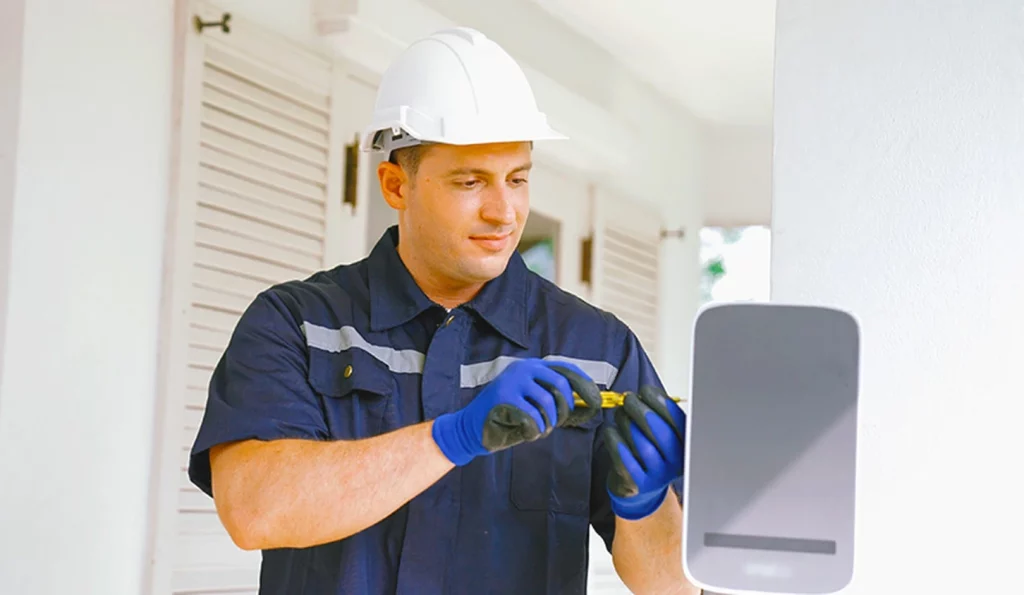Proper installation of an EV charger is critical to maintaining its functionality and longevity. Many users overlook essential factors, leading to costly errors. Compliance with local codes and evaluating electrical capacity are often neglected. Additionally, the charger’s location can greatly impact safety and efficiency. Understanding these aspects can prevent common mistakes during EV charger installation, ensuring the system runs smoothly and safely. An exploration of these installation considerations reveals strategies to protect investments effectively.
Key Takeaways
- Always comply with local electrical codes to avoid penalties and ensure safe installation.
- Assess your electrical supply to meet the continuous load demand of the charger.
- Use qualified professionals for installation to minimize errors and ensure safety compliance.
- Choose a suitable location for the charger to enhance accessibility and protect it from elements.
- Regularly maintain the charger to identify potential issues and prolong its lifespan.
Understanding the Importance of Proper EV Charger Installation
While the convenience of electric vehicle (EV) ownership is undeniable, the significance of proper EV charger installation cannot be overstated. Ensuring that an EV charger is installed correctly is vital for peak performance and safety. An improperly installed charger can lead to inefficient charging, increased energy costs, and potential hazards such as electrical fires. Additionally, adherence to local regulations and standards is essential to maintain warranty coverage and avoid legal complications. Proper installation also enhances the longevity of the charging equipment, thereby protecting the owner’s investment. By prioritizing meticulous installation practices, EV owners can foster a reliable and efficient charging experience, contributing to the broader acceptance and integration of electric vehicles within their communities.
Identifying Common Mistakes During EV Charger Installation
Identifying common mistakes during EV charger installation is crucial for ensuring safe and efficient operation. Such errors can lead to equipment damage, safety hazards, and diminished performance. Recognizing these pitfalls can help homeowners and installers alike. The following are four prevalent mistakes:
- Ignoring Local Codes: Failing to adhere to local electrical codes can result in non-compliance and penalties.
- Neglecting Circuit Requirements: Underestimating the necessary circuit specifications may lead to overload and potential failure.
- Improper Placement: Installing the charger in a location without proper accessibility or ventilation can impede functionality.
- Using Inadequate Wiring: Utilizing wiring that does not meet the charger’s requirements can cause overheating and inefficiencies.
Addressing these common mistakes during EV charger installation is essential for peak performance and safety.
Ensuring Adequate Electrical Supply for Your EV Charger
Guaranteeing the proper electrical supply for an EV charger is a fundamental aspect that directly impacts its performance and safety. A common mistake during EV charger installation is underestimating the electrical capacity required for the charger’s specific model. It is essential to evaluate the home’s existing electrical system, including the panel’s amperage and the circuit’s voltage rating. Additionally, the installation must accommodate the continuous load demand of the charger, necessitating an appropriately rated circuit breaker. Engaging a qualified electrician can help assess the electrical supply and verify compliance with local codes. By prioritizing adequate electrical supply, owners can enhance charging efficiency, reduce the risk of electrical hazards, and protect their investment in the EV charging infrastructure.

Choosing the Right Location for Your EV Charger
Selecting the ideal location for an EV charger is essential, as it influences both accessibility and safety. Proper placement can greatly reduce the likelihood of common mistakes during EV charger installation. Consider the following factors when choosing a location:
- Proximity to Parking: Confirm the charger is near the vehicle’s parking space to facilitate easy access.
- Weather Protection: Select a sheltered area to protect the charger from harsh weather conditions, prolonging its lifespan.
- Cable Management: Plan for efficient cable routing to avoid tripping hazards and damage to the charger.
- Compliance with Regulations: Verify that the location meets local building codes and safety standards to prevent future liabilities.
Hiring Qualified Professionals for Installation and Maintenance
While it may seem tempting to undertake EV charger installation as a DIY project, hiring qualified professionals is crucial for achieving ideal performance and safety. Experienced technicians possess the necessary knowledge of electrical systems and local codes, considerably reducing the likelihood of common mistakes during EV charger installation. Their expertise guarantees that the installation adheres to safety standards, ultimately protecting both the user and the vehicle. Additionally, professionals can provide ongoing maintenance, identifying potential issues before they escalate. This proactive approach not only enhances the longevity of the charger but also safeguards the investment. In a rapidly evolving technological landscape, relying on skilled installers fosters a sense of community among EV users, promoting shared values of sustainability and innovation.
Frequently Asked Questions
What Tools Are Needed for EV Charger Installation?
For EV charger installation, essential tools include a drill, wire strippers, screwdrivers, a voltage tester, and various wrenches. Proper tools guarantee efficient installation and help avoid common mistakes during EV charger installation, securing long-term reliability.
How Long Does the Installation Process Typically Take?
The installation process for an EV charger typically ranges from four to eight hours, depending on existing electrical infrastructure and complexity. Proper planning greatly mitigates common mistakes during EV charger installation, ensuring efficiency and safety.
Can I Install an EV Charger Myself?
The question of self-installing an EV charger often arises. While technically feasible, it poses risks and complexities. Engaging a qualified professional minimizes potential errors and guarantees compliance with safety standards, ultimately safeguarding the investment.
What Permits Are Required for EV Charger Installation?
The installation of an EV charger typically requires specific permits, which vary by locality. Homeowners should consult local regulations to guarantee compliance, as obtaining the correct permits is essential to avoid legal complications and installation errors.
How Do I Maintain My EV Charger After Installation?
Maintaining an EV charger involves regular inspections, ensuring proper cleanliness, checking connections for wear, verifying software updates, and monitoring performance metrics. These actions help prevent common mistakes during EV charger installation that could compromise functionality.
Conclusion
In summary, meticulous attention to detail during EV charger installation is paramount to safeguarding both the equipment and the investment. By understanding common pitfalls, guaranteeing sufficient electrical supply, selecting an ideal location, and enlisting qualified professionals, one can greatly mitigate risks associated with improper installation. Adhering to these essential guidelines not only enhances the charger’s performance and longevity but also assures compliance with safety standards, ultimately fostering a reliable and efficient electric vehicle charging experience.
You May Also Like to Read:

